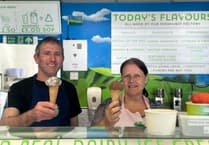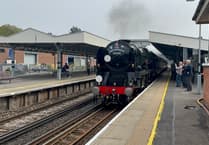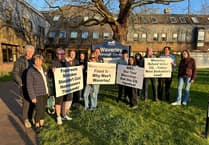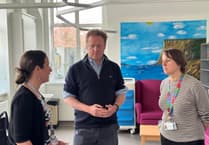Julia Tanner has stepped down as curator of Haslemere Educational Museum after 21 years in the role, having previously worked at the Horniman Museum in London and University of Cambridge Museum of Archaeology and Anthropology.
Julia did her masters degree in museum studies at Cambridge University. She started as curator at Haslemere Museum in 2002, halfway through the museum’s Heritage Lottery-funded redevelopment project, working on the natural history and human history galleries in particular, but also dealing with snagging issues relating to the new build elements of the project, and helping to organise a grand reopening event.
Recounting her recruitment as curator, Julia said: “I was working at the Horniman Museum in London, when a colleague shouted down a long corridor in the depths of the Study Collections Centre that someone called Penny was on the phone for me.
“That turned out to be Penny Hollow, a trustee of Haslemere Museum, saying they were looking for a new curator. I came down to be interviewed in the museum library by then trustees Bernard Coe and Richard Muir, and the rest is history.”
Julia’s time in post as curator has been busy and eventful, with exhibitions, events, projects and lectures, as well as themed weekends, refurbishments, upgrades, book publishing, VIP visits and awards.
Back in the early 2000s she secured Heritage Lottery funding for a project called Places for People, which introduced the first Early Years workshops, and also funded illustrated panels about Haslemere history and interpretation boards about the museum’s historic landscaped garden and grounds.
Among the many projects, Julia suggested the idea of the successful ‘Museum in a Million’ fundraising campaign in 2013, which resulted in raising money for the endowment fund.
Also during her tenure, a number of museum spaces have been refurbished with grant funding and a dedicated Quarantine Room has been introduced for managing infestation risks to collections from incoming specimens.
While in post, Julia has gained the museum several national awards, including The Telegraph Family Friendly Museum Award (2012), the Museums + Heritage Nation’s Favourite Museum Award (2012) and the Museums + Heritage Award for Project on a Limited Budget (2014).
In 2018, the museum won the Museums + Heritage Award for Fundraising Initiative of the Year for the Museum in a Million fundraising campaign.
Over the past 21 years, Julia has successfully applied for museum accreditation with Arts Council England on a number of occasions, since it has to be renewed on a regular basis. The most recent award for full accreditation in 2018 stated: “There were no areas for improvement recommended which reflects the quality of your return.”
In 2016, Julia also successfully applied for the Queen’s Award for Voluntary Service on behalf of the volunteers of the museum. Equivalent to an MBE, this is the highest award a voluntary group can receive to recognise outstanding work in their communities.
During her busy time at the museum, Julia has introduced new visitor leaflets and events, produced various policies, protocols and grant applications, and even mentored Dorking Museum, which is a smaller, volunteer-run museum.
For six years, she and colleagues Robert Neller and John Betterton worked in partnership with The Geological Association, coordinating with geologists and other experts, to produce a book on the eminent geologist, Sir Archibald Geikie, who was the museum’s first chairman and whose archive recording his life and career is held at the museum.
More recently, Julia secured the prestigious British Museum Spotlight Loan Troy: beauty and heroism in 2022, which also saw the VIP visit of Dame Professor Mary Beard for the private view. Julia also acquired funding from The British Museum Trust to make upgrades to the galleries as part of the loan.
At her leaving party, Julia described her time at the museum as a wonderful rich tapestry, saying she had collected many great memories to take away with her. She said: “It has been an honour being part of the museum family and also being involved in the community of Haslemere. I thank every one of you who has made my time as curator so special, and I wish you all, and the museum, the very best for the future.”





Comments
This article has no comments yet. Be the first to leave a comment.